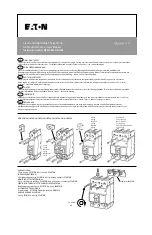
3-20
B30 BUS DIFFERENTIAL SYSTEM – INSTRUCTION MANUAL
WIRING
CHAPTER 3: INSTALLATION
3
For high-density input/output modules 6W and 6X, use the following guidelines to connect:
•
12 to 24 AWG (3.3 mm
2
to 0.2 mm
2
), single wire termination
•
16 to 24 AWG (1.31 mm
2
to 0.2 mm
2
), multiple wire termination with matching wire sizes and stranding. Two wires
maximum per circuit.
•
Suggested wiring screw tightening torque is a minimum 4.43 in-lb (0.5 Nm) and maximum 5.31 in-lb (0.6 Nm)
•
Minimum suggested temperature rating for the conductors is 75°C
•
Wire type: copper
•
Do not use with SL power supply module
Table 3-3: Contact input and output module assignments
USE OF FORM-A AND SOLID-STATE RELAY OUTPUTS IN HIGH-IMPEDANCE CIRCUITS
For form-A and solid-state relay output contacts internally equipped with a voltage measuring circuit across the
contact, the circuit has an impedance that can cause a problem when used in conjunction with external high-input
impedance monitoring equipment, such as modern relay test set trigger circuits. These monitoring circuits can
continue to read the form-A contact as being closed after it has closed and subsequently opened, when measured
as an impedance.
The solution is to use the voltage measuring trigger input of the relay test set, and connect the form-A contact
through a voltage-dropping resistor to a DC voltage source. If the 48 V DC output of the power supply is used as a
source, a 500
Ω
, 10 W resistor is appropriate. In this configuration, the voltage across either the form-A contact or
the resistor can be used to monitor the state of the output.
Where a tilde “~” symbol appears, substitute the slot position of the module. Where a number sign “#” appears,
substitute the contact number.
When current monitoring is used to seal-in the form-A and solid-state relay contact outputs, give the
FlexLogic operand driving the contact output a reset delay of 10 ms to prevent damage of the output
contact (in situations when the element initiating the contact output is bouncing, at values in the
region of the pickup value).
~6A module
~6B module
~6C module
~6D module
Terminal
assignment
Output or
input
Terminal
assignment
Output or
input
Terminal
assignment
Output
Terminal
assignment
Output
~1
Form-A
~1
Form-A
~1
Form-C
~
1a,
~
1c
2 Inputs
~2
Form-A
~2
Form-A
~2
Form-C
~
2a,
~
2c
2 Inputs
~3
Form-C
~3
Form-C
~3
Form-C
~
3a,
~
3c
2 Inputs
~4
Form-C
~4
Form-C
~4
Form-C
~
4a,
~
4c
2 Inputs
~5a, ~5c
2 Inputs
~5
Form-C
~5
Form-C
~
5a,
~
5c
2 Inputs
~6a, ~6c
2 Inputs
~6
Form-C
~6
Form-C
~
6a,
~
6c
2 Inputs
~7a, ~7c
2 Inputs
~7a, ~7c
2 Inputs
~7
Form-C
~
7a,
~
7c
2 Inputs
~8a, ~8c
2 Inputs
~8a, ~8c
2 Inputs
~8
Form-C
~
8a,
~
8c
2 Inputs
~6E module
~6F module
~6G module
~6H module
Terminal
assignment
Output or
input
Terminal
assignment
Output
Terminal
assignment
Output or
input
Terminal
assignment
Output or
input
~
1
Form-C
~
1
Fast Form-C
~
1
Form-A
~1
Form-A
~
2
Form-C
~
2
Fast Form-C
~
2
Form-A
~2
Form-A
~
3
Form-C
~
3
Fast Form-C
~
3
Form-A
~3
Form-A
~
4
Form-C
~
4
Fast Form-C
~
4
Form-A
~4
Form-A
Summary of Contents for b30
Page 10: ...x B30 BUS DIFFERENTIAL SYSTEM INSTRUCTION MANUAL TABLE OF CONTENTS ...
Page 486: ...5 278 B30 BUS DIFFERENTIAL SYSTEM INSTRUCTION MANUAL TESTING CHAPTER 5 SETTINGS 5 ...
Page 616: ...iv B30 BUS DIFFERENTIAL SYSTEM INSTRUCTION MANUAL ABBREVIATIONS ...
Page 632: ...xvi B30 BUS DIFFERENTIAL SYSTEM INSTRUCTION MANUAL INDEX ...









































